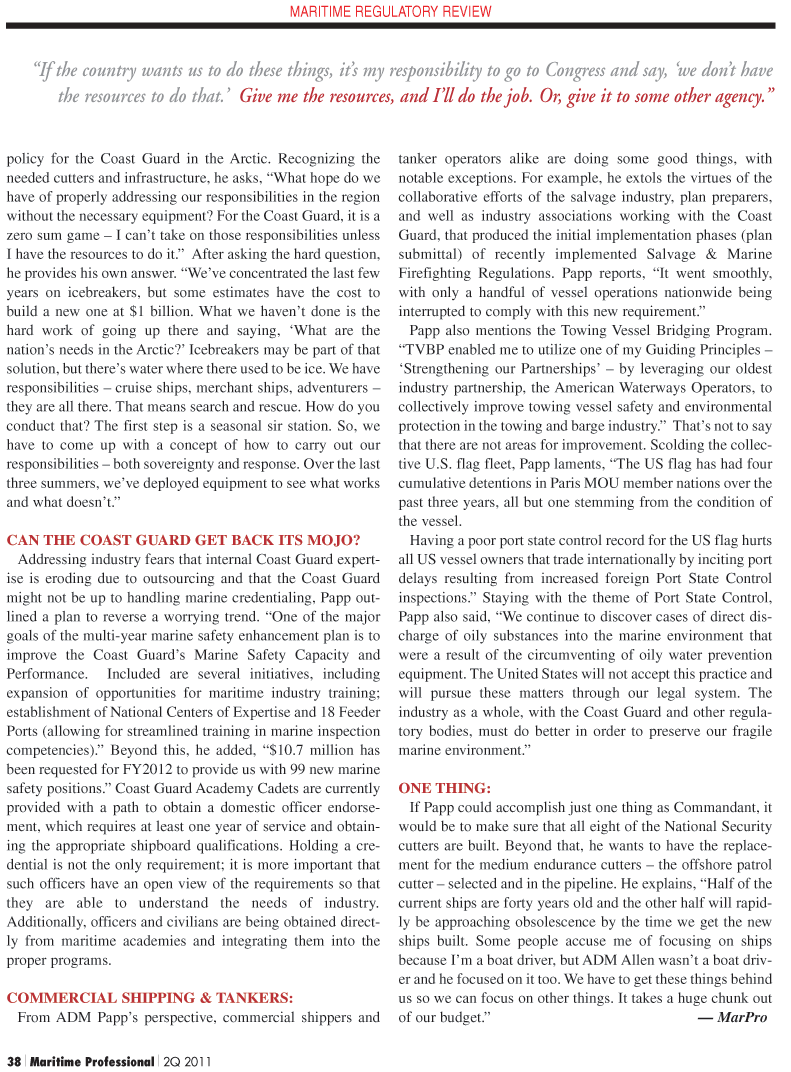
Page 38: of Maritime Logistics Professional Magazine (Q2 2011)
Energy Transportation
Read this page in Pdf, Flash or Html5 edition of Q2 2011 Maritime Logistics Professional Magazine
38 Maritime Professional 2Q 2011 policy for the Coast Guard in the Arctic. Recognizing the needed cutters and infrastructure, he asks, “What hope do we have of properly addressing our responsibilities in the region without the necessary equipment? For the Coast Guard, it is a zero sum game – I can’t take on those responsibilities unless
I have the resources to do it.” After asking the hard question, he provides his own answer. “We’ve concentrated the last few years on icebreakers, but some estimates have the cost to build a new one at $1 billion. What we haven’t done is the hard work of going up there and saying, ‘What are the nation’s needs in the Arctic?’ Icebreakers may be part of that solution, but there’s water where there used to be ice. We have responsibilities – cruise ships, merchant ships, adventurers – they are all there. That means search and rescue. How do you conduct that? The first step is a seasonal sir station. So, we have to come up with a concept of how to carry out our responsibilities – both sovereignty and response. Over the last three summers, we’ve deployed equipment to see what works and what doesn’t.”
CAN THE COAST GUARD GET BACK ITS MOJO?
Addressing industry fears that internal Coast Guard expert- ise is eroding due to outsourcing and that the Coast Guard might not be up to handling marine credentialing, Papp out- lined a plan to reverse a worrying trend. “One of the major goals of the multi-year marine safety enhancement plan is to improve the Coast Guard’s Marine Safety Capacity and
Performance. Included are several initiatives, including expansion of opportunities for maritime industry training; establishment of National Centers of Expertise and 18 Feeder
Ports (allowing for streamlined training in marine inspection competencies).” Beyond this, he added, “$10.7 million has been requested for FY2012 to provide us with 99 new marine safety positions.” Coast Guard Academy Cadets are currently provided with a path to obtain a domestic officer endorse- ment, which requires at least one year of service and obtain- ing the appropriate shipboard qualifications. Holding a cre- dential is not the only requirement; it is more important that such officers have an open view of the requirements so that they are able to understand the needs of industry.
Additionally, officers and civilians are being obtained direct- ly from maritime academies and integrating them into the proper programs.
COMMERCIAL SHIPPING & TANKERS:
From ADM Papp’s perspective, commercial shippers and tanker operators alike are doing some good things, with notable exceptions. For example, he extols the virtues of the collaborative efforts of the salvage industry, plan preparers, and well as industry associations working with the Coast
Guard, that produced the initial implementation phases (plan submittal) of recently implemented Salvage & Marine
Firefighting Regulations. Papp reports, “It went smoothly, with only a handful of vessel operations nationwide being interrupted to comply with this new requirement.”
Papp also mentions the Towing Vessel Bridging Program. “TVBP enabled me to utilize one of my Guiding Principles – ‘Strengthening our Partnerships’ – by leveraging our oldest industry partnership, the American Waterways Operators, to collectively improve towing vessel safety and environmental protection in the towing and barge industry.” That’s not to say that there are not areas for improvement. Scolding the collec- tive U.S. flag fleet, Papp laments, “The US flag has had four cumulative detentions in Paris MOU member nations over the past three years, all but one stemming from the condition of the vessel.
Having a poor port state control record for the US flag hurts all US vessel owners that trade internationally by inciting port delays resulting from increased foreign Port State Control inspections.” Staying with the theme of Port State Control,
Papp also said, “We continue to discover cases of direct dis- charge of oily substances into the marine environment that were a result of the circumventing of oily water prevention equipment. The United States will not accept this practice and will pursue these matters through our legal system. The industry as a whole, with the Coast Guard and other regula- tory bodies, must do better in order to preserve our fragile marine environment.”
ONE THING:
If Papp could accomplish just one thing as Commandant, it would be to make sure that all eight of the National Security cutters are built. Beyond that, he wants to have the replace- ment for the medium endurance cutters – the offshore patrol cutter – selected and in the pipeline. He explains, “Half of the current ships are forty years old and the other half will rapid- ly be approaching obsolescence by the time we get the new ships built. Some people accuse me of focusing on ships because I’m a boat driver, but ADM Allen wasn’t a boat driv- er and he focused on it too. We have to get these things behind us so we can focus on other things. It takes a huge chunk out of our budget.” — MarPro
MARITIME REGULATORY REVIEW “If the country wants us to do these things, it’s my responsibility to go to Congress and say, ‘we don’t have the resources to do that.’ Give me the resources, and I’ll do the job. Or, give it to some other agency.”

 37
37

 39
39
